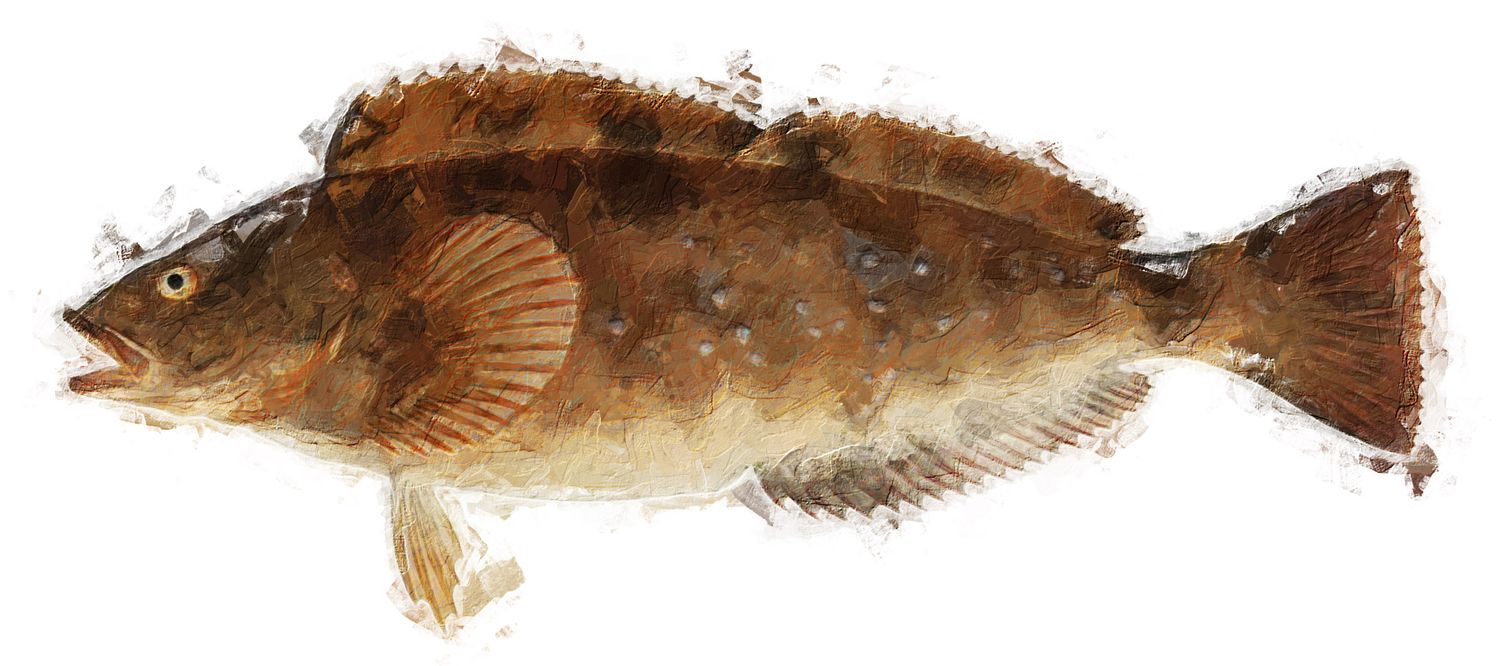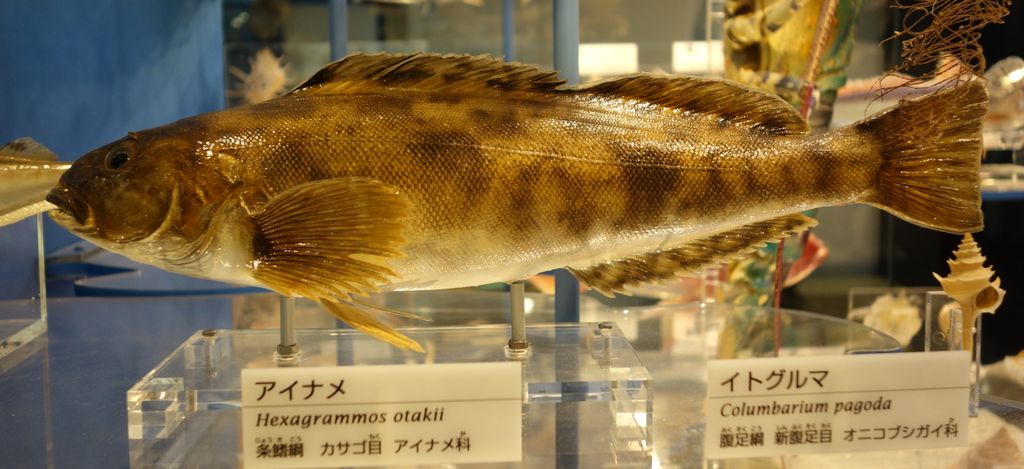Ainame Sushi
A Comprehensive Overview of Greenling in Japanese Sushi Cuisine
アイナメすし 、 鮎魚女寿司 
What is Ainame?
The term ainame 鮎並 is predominantly used in Japanese for the fat greenling. In addition, the name also refers to other fish belonging to the family of greenlings (ainame-ka アイナメ科). Ainame is a popular fish in Japan, which prefers low-salt sea regions and is widely distributed along the coast of Japan. In addition to its use for sushi and sashimi, it is also an ingredient in many other dishes of Japanese cuisine.
Ainame for Sushi or Sashimi
The meat of the ainame is white, has a slightly sweet mild, yet aromatic flavor. The meat owes its strikingly light color to its high fat content. The texture is firm and elastic, but not tough. Fresh fish is preferred for the preparation of sashimi, but is also well suited for the preparation of ainame nigiri. The skin is delicious and fatty, which is why flamed (aburi 炙り) or blanched ainame is also an appealing alternative for sushi or sashimi. This is done by either flaming the skin crisp with a blowtorch or pouring hot water over (kawashimo zukuri, 皮霜造り) it while leaving the rest of the meat raw.
Best Season
The taste is quite stable throughout the year, with the best season being from spring to summer, when the fish are more fatty and aromatic. Top specimens trade at remarkably high prices at this time of year.
Ainame in Japan
When comparing the Japanese characters 鮎並 for ainame and 鮎 for ayu, it can be seen that both contain the character for ayu, a well-known freshwater fish species. This similarity is sometimes interpreted to mean that ainame males protect their fry with a similar dedication as an ayu. It is also sometimes suggested that the character indicates that the appearance of an adult ainame is similar to that of an adult ayu. However, even a brief examination reveals that these fish have very little in common visually. However, it is important to treat such interpretations with caution, as direct historical or scientific evidence for these specific meanings of the characters is not clear in the available literature.
Ecology of Ainame

Daderot. Pleurogrammus azonus - National Museum of Nature and Science, Tokyo. Wikimedia Commons. Some rights reserved: CC0 1.0
Ainame prefers rocky coastal areas, shallow water below the tidal zone, occasionally also artificial reefs if covered by algae or seaweed. The distribution area extends along various parts of Japan except the Nansei Islands to the Korean Peninsula, the Yellow Sea coasts and southern Sakhalin. They usually reach a length of about 57 centimeters and weigh about 5 pounds (2.27 kg). They are typically found on rough soils at depths of 140 to 155 meters. Ainame are a nocturnal species that lives territorially in rocky coastal areas. Their diet consists mainly of smaller fish, snails, mollusks, and crustaceans. They have a certain importance for Japanese commercial fishing.
The spawning season is from late autumn to winter. In the colder waters of Hokkaido, it starts already in September and ends in November. At this time of year, the scales of the male take on a golden color, which is called wedding color koninshoku 婚姻色. During this time, the males migrate into shallower water and form precincts there, in which they guard and care for the eggs fastened at small rocks. Although the males are responsible for the brood care, it was observed occasionally that they partially eat the carefully maintained eggs. The reason for this cannibalism is not yet conclusively clarified by science.[1]
Economy of Ainame

SushiPedia. Japanese fishing trawler during a storm. All rights reserved ©
In the market mainly individuals with a length of 30 to 40 cm can be found, occasionally they reach a size of up to 60 cm. The economic importance is low, in Japan a commercial breeding in aquacultures takes place sporadically. The most common fishing methods include by-catch in trawls, gill nets or pots. Furthermore, ainame is a popular catch for sport fishing.
The economic importance in relation to large-scale fisheries is so small that the Food and Agriculture Organization of the United Nations (FAO) does not explicitly include ainame (Hexagrammos otakii) in its statistics.
Season Calendar for Ainame
The calendar shown does not provide information on fishing times, but marks the periods in which ainame is considered particularly tasty.
Warnings related to Ainame
Video about Ainame Sushi
External video embedded from: youTube.com. Credit 魚屋の森さん. 【豪華】この時期だからこそ手に入る?高級魚「アイナメ」と日本酒「獺祭」で最高級の酒蒸しを頂きます!.
Species of Ainame
The following species are regarded as authentic ainame. Either historically, according to the area of distribution or according to the common practice in today's gastronomy:
In the following, those species are listed that can be considered as substitutes for authentic species with regard to ainame. This can be based either on their genetic relationship or on their similarity in taste and appearance. The selection is subjective and is not strictly based on Japanese conventions, but also takes into account the practices in the respective areas where the Japanese dishes are prepared. This flexible approach allows for adaptation to local availability and preferences while preserving the core flavor and texture traditionally associated with ainame.
Sources and Further Reading
- [1]Hiroyuki Munehara, Teisuke Miura. Non-intentional filial egg cannibalism by the guarding male of Hexagrammos otakii (Pisces: Hexagramidae). Journal of Ethology 13 (191). 1995
- [2]Hartford Williams. Parasitic Worms Of Fish. CRC Press, Taylor & Francis Group, Boca Raton. 1994
- Celeste Heiter. The Sushi Book. Things Asian Press. 2007
- Munehara Hiroyuki, Takenaka Osamu. Microsatellite markers and multiple paternity in a paternal care fish, Hexagrammos otakii. Journal of Ethology 18 (2) 101-104. 2000
- Rainer Froese, Pauly Daniel. FishBase. The Leibniz Institute of Marine Sciences at the University of Kiel, FishBase.org, 2019. Source retrieved 12/24/2020
- Richard Hosking. A Dictionary of Japanese Food: Ingredients & Culture. Tuttle Publishing, North Clarendon. 2015
- 藤原昌高. 『すし図鑑 (Sushi Picture Book)』. Mainabi Shuppan (マイナビ出版). 2013
- IUCN Red List of Threatened Species. Version 2023-1
Image Credits
- SushiPedia. Ainame. All rights reserved ©
- Daderot. Pleurogrammus azonus - National Museum of Nature and Science, Tokyo. Wikimedia Commons. Some rights reserved: CC0 1.0